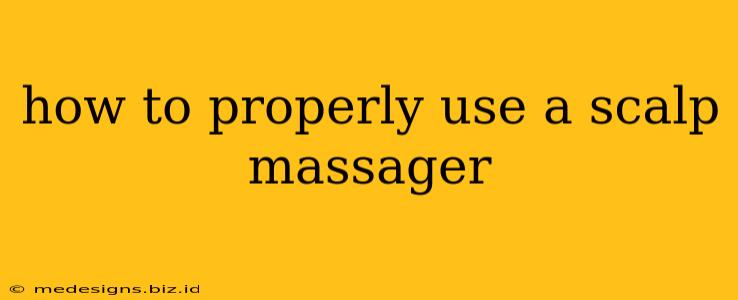Are you experiencing stress, tension headaches, or simply want to improve your hair health? A scalp massager can be a fantastic addition to your self-care routine. But using it correctly is key to maximizing its benefits. This comprehensive guide will walk you through the proper techniques and answer frequently asked questions about using a scalp massager.
Understanding the Benefits of Scalp Massage
Before diving into the how-to, let's understand why scalp massage is beneficial. A good scalp massage can:
- Relieve stress and tension: The gentle pressure and rhythmic movements can help relax tense muscles in your scalp and neck, reducing stress and promoting relaxation.
- Improve blood circulation: Increased blood flow to the scalp nourishes hair follicles, potentially stimulating hair growth and improving overall hair health.
- Reduce headaches: Massaging your scalp can help alleviate tension headaches by relaxing the muscles in your head and neck.
- Exfoliate the scalp: Certain scalp massagers can help remove dead skin cells and product buildup, leading to a cleaner and healthier scalp.
- Enhance the absorption of hair products: Massaging your scalp while applying hair products can help improve their absorption, maximizing their effectiveness.
Choosing the Right Scalp Massager
Several types of scalp massagers are available, each with its own advantages:
- Manual scalp massagers: These are typically handheld devices with various textures and shapes designed to stimulate the scalp. They are affordable and easy to use.
- Electric scalp massagers: These offer a more powerful and potentially deeper massage, often with adjustable intensity settings. They can be more expensive than manual ones.
- Silicone scalp massagers: Known for their gentle touch, these are particularly good for sensitive scalps.
How to Use a Scalp Massager: A Step-by-Step Guide
Regardless of the type of massager you choose, follow these steps for optimal results:
1. Preparation is Key:
- Cleanse your hair: Start with clean, dry or damp hair. This will ensure a more comfortable and effective massage.
- Apply hair oil (optional): Adding a small amount of hair oil, like coconut oil or argan oil, can reduce friction and enhance the massage experience.
2. The Massage Technique:
- Start gently: Begin with light pressure and gradually increase intensity as you become comfortable.
- Use circular motions: Most scalp massagers work best with circular motions. Move the massager in small, gentle circles across your scalp.
- Cover all areas: Pay attention to all areas of your scalp, including the hairline, crown, and nape of your neck.
- Vary the pressure: Alternate between gentle and firm pressure to maximize stimulation and relaxation.
- Listen to your body: If you feel any pain, stop immediately and reduce the pressure.
3. Duration and Frequency:
- Start with short sessions: Begin with 5-10 minutes of massage and gradually increase the duration as needed.
- Consistency is key: Aim for regular scalp massages, ideally 2-3 times a week.
Frequently Asked Questions (FAQs)
Q: Can I use a scalp massager every day?
A: While daily use isn't harmful for most people, it’s best to start with a few times a week and see how your scalp responds. Over-massaging can sometimes irritate the scalp.
Q: Are scalp massagers good for hair growth?
A: While scalp massage alone won't magically make your hair grow faster, it can improve blood circulation to the scalp, potentially supporting hair growth by nourishing hair follicles. It's best used in conjunction with a healthy diet and hair care routine.
Q: Can scalp massagers help with dandruff?
A: Some scalp massagers can help remove dead skin cells, which may reduce dandruff. However, if you have severe dandruff, it’s important to consult a dermatologist.
Conclusion
Using a scalp massager can be a simple yet effective way to relieve stress, promote hair health, and improve your overall well-being. By following these guidelines and choosing the right massager for your needs, you can enjoy the many benefits of regular scalp massage. Remember to listen to your body and adjust the technique as needed for a truly relaxing and revitalizing experience.
